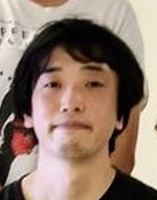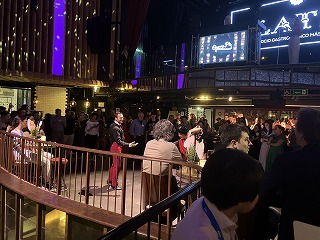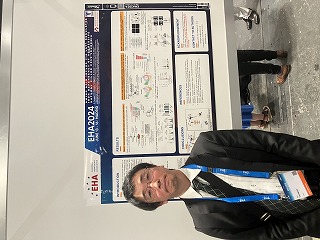29th EHA Congress Travel Award 受賞レポート 栁谷 稜

名前:栁谷 稜【大阪大学微生物病研究所環境応答研究部門 感染腫瘍制御分野】
発表形式:Poster
Title:
Amino acid influx via LAT1 regulates iron dependency of aggressive natural killer cell leukemia
Authors:
Ryo Yanagiya 1, 2, Natsumi Watanabe 3, Joaquim Carreras 4, Makoto Onizuka 1, Naoya Nakamura 4, and Ai Kotani 2
Affiliations:
1. Department of Hematology and Oncology, Tokai University School of Medicine, Isehara, Japan
2. Research Institute for Microbial Diseases, Osaka University, Suita, Japan
3. Department of Innovative Medical Science, Tokai University, Iseahara, Japan
4. Department of Pathology, Tokai University School of Medicine, Isehara, Japan
Abstract:
Background: Aggressive natural killer cell leukemia (ANKL) is a rare hematological malignancy with a fulminant clinical course. Despite several retrospective analyses indicate the efficacy of L-asparaginase containing combination chemotherapies, there is no established standard of care due to disease rarity. Under the circumstances, we previously established ANKL disease mouse models (patient-derived xenograft mice), and discovered that ANKL cells proliferate predominantly in the liver sinusoids and strongly depend on transferrin supplementation by analyzing the models. In addition, we demonstrated that liver-resident ANKL cells are quite sensitive to PPMX-T003, an anti-human transferrin receptor 1 inhibitory antibody. Based on this investigation, a phase Ib/II clinical trial to uncover the safety and efficacy of PPMX-T003 to ANKL is ongoing. However, extrahepatic ANKL cells were resistant to transferrin receptor blockage, indicating that the iron dependency of ANKL is determined by environmental factors they localize.
Aims: We investigated the contribution of microenvironmental factors to iron dependency of ANKL.
Methods: Connectivity scoring analysis of transcriptome and in vivo CRISPR screening was performed to detect molecules contributing to PPMX-T003-derived cellular toxicities in ANKL. An anti-γH2AX antibody and propidium iodide were used to assess the cell cycle-dependent DNA damage induction. Single cell RNA sequence was used to detect molecules specifically expressed at the S phase cell cycle, followed by targeted cell knockout analyses to reveal its function using CRISPR/Cas9 system. JPH-203 was used to assess the contribution of LAT1-mediated cellular amino acid influx to antineoplastic effect of PPMX-T003 towards ANKL cells.
Results: We first revealed that the anti-neoplastic effect of PPMX-T003 was characterized by DNA double-strand breaks in a DNA replication-dependent manner, similar to conventional cytotoxic agents, by connectivity scoring analysis of transcriptome. Furthermore, in vivo CRISPR screening using sgRNA library targeting genes encoding iron-requiring molecules uncovered that liver-resident ANKL cells depend on extracellular iron supplementation mainly for DNA replication and repair at S phase of cell cycle, rather than proliferative signal initiation. Thus, we further investigated the environmental factor contributing to proliferation of ANKL using single cell RNA-seq, and found that SLC7A5, a gene coding a large neutral amino acid transporter 1 (LAT1), is specifically expressed in of S phase ANKL cells. and its inhibition or knockout resulted in growth impairment due to G1 arrest. Among amino acids transported via LAT1, sulfur-containing amino acids were annotated as key regulators of ANKL proliferation, and ANKL cells in environment with lower concentration of them decreased cell growth activity and cellular iron requirement, and resisted to PPMX-T003. LAT1 inhibition by an inhibitor, JPH-203, also decrease growth activity of ANKL and provide resistance against PPMX-T003 for them.
Summary/Conclusion: Taken together, we discovered that the amount of extracellular sulfur amino acid influx through LAT1 was the key environmental factor determining the iron dependency of ANKL cells, which provides a good explanation for the different sensitivity to PPMX-T003 between liver- and spleen-resident ANKL cells, as the liver sinusoid contains abundant amino acids absorbed from the gut.
EHA2024参加レポート
今回,JSH-EHA Travel Grant Program for EHA2024に採択いただき,参加させていただきました。私にとって初めての海外学会での発表ということもあり,期待と不安を胸に準備を進めていきました。
4日間の会期のスタートダッシュは,YoungEHAという若手教育と振興を目的としたワーキンググループによる,各領域の最先端の研究活動を紹介するセッションでした。今回は4つの領域についてエキスパートのKeynote Lectureと若手研究者による高いクオリティの研究発表が行われ,最後にパネルディスカッション形式での質疑応答が行われるという形でしたが,単なる教育講演にとどまらない,若手のリサーチマインドを刺激する実に熟慮されたプログラム構成に感動を覚えました。中でも“Immune therapies and inflammation in hematology/oncology”のセッションにおける,AMLの炎症シグナルを標的とした新たな治療標的探索に関する研究や,“Metabolism in non-malignant and malignant hematopoiesis”のセッションにおける,ヌクレオチド組成のimbalanceが複製フォークストレスを介して腫瘍細胞の分化を助長するという内容のKeynote lectureは大変面白く,座長の“Don’t be shy!”の声掛けも相まってついつい質問マイクに手が伸びてしまいました。その後行われたGrant受賞者対象の交流会では,短い時間ながらスペインや英国をはじめとした欧州の若手~中堅血液学会員と各国における血液学研究者の教育体制について議論する時間が持て,ASHやEHAが行っているようなClinical Research Trainee’s Programの存在の大きさを改めて実感することが出来ました。また,2日目以降は一般演題を中心にジャンルを絞らず様々な領域のセッションに参加させていただきましたが,Oral sessionに採択される研究の質の高さと綿密さにただただ圧倒されるばかりでした。日本からの演題も数件拝聴出来,励みになると同時にその場に立てなかったことを悔しくも感じ,帰国後は益々研究に邁進していこうと決意を新たにすることが出来ました。
2日目の夜にはポスターセッションが開催され,幸いなことに私のポスターも多くの方にご覧いただき,忌憚のないご意見をいただくことが出来ました。また,私が今回発表したテーマは希少疾患のため同一のテーマで研究を行っている施設は極めて少ないのですが,今回ポスターセッションにて私たちの先行研究に感化されて同一の疾患の基礎研究を開始したというオーストリアの研究チームに巡り合うことが出来,とてもうれしく思うとともに研究成果を論文という形で世界へ発信することの意義を実感することが出来ました。
3日目の夜には親睦会(EHA grooves)が開催され,情熱的なフラメンコのショーの中で,おいしいスペインワインと料理を楽しむことが出来ました。Grant受賞者の先生方との交流を通して,それぞれの先生方の研究の話やキャリアパスなどについてお話を聞けたことも自分にとっては大きな収穫となりました。

会期を通して聞き逃せないセッションや演題ばかりで観光する余裕がなく,今回は空港,会場,ホテルの行き来に終始してしまいましたが,ホテルレストランでいただいた料理やスペインビール(Mahou beer)のおいしさに感動することもでき,またレンガ造りが主体のスペインの街並みを目で楽しむ機会を持つこともでき,そういった意味でも勇気を出してGrantへ応募してよかったな,と思いました。

自分の年次を考えると,今後は新しく血液学を専攻すると決めてくださった先生方へ,どのようにリサーチマインドを持っていただくかを考えていかなければならない立場だと考えています。臨床・基礎問わず,「わからないことの最前線」で鎬を削る研究の面白さを,今後は様々な形で国内でも発信していきたいと考えています。その結果として,前制度から形を変えて今年度から開始となった本Travel Grant Programが,より多数の応募で盛況し,レベルの高いものへ昇華すると嬉しく思います。
最後になりましたが,貴重な機会を与えてくださりました日本血液学会と欧州血液学会,ならびに所属研究室に感謝申し上げます。
